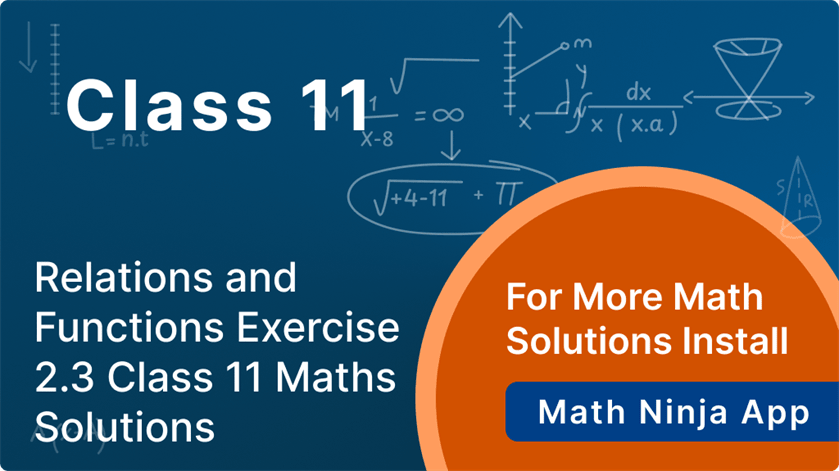Class 11 maths relations and functions || ncert solutions for class 11 maths chapter 2 || ncert exemplar class 11 maths || class 11 ch 2 exercise 2.3 solutions || class 11 maths ncert solutions || exercise 2.3 class 11 maths solutions || class 11 chapter 2 exercise 2.3 solution
Mastering Chapter 2: Relations and Functions becomes much easier with our well-structured solutions for Exercise 2.3. This part of the chapter plays a key role in building your base for higher-level maths topics. Each solution is crafted to be simple, accurate and aligned with the latest CBSE syllabus. Whether you’re revising or learning it for the first time, these step-by-step answers will help you gain clarity and confidence. By spending time on this exercise, you’ll enhance both your conceptual understanding and problem-solving approach—skills essential for scoring well in exams.

class 11 maths relations and functions || ncert solutions for class 11 maths chapter 2 || ncert exemplar class 11 maths || class 11 ch 2 exercise 2.3 solutions || class 11 maths ncert solutions || exercise 2.3 class 11 maths solutions || class 11 chapter 2 exercise 2.3 solution
Exercise 2.3
1A. Which of the following relations are functions? Give reasons. If it is a function, determine its domain and range.
\(\{(2,1),(5,1),(8,1),(11,1),(14,1),(17,1)\}\)
\(\{(2,1),(5,1),(8,1),(11,1),(14,1),(17,1)\}\)
Answer
Since, \( 2,5,8,11,14 \) and 17 are the elements of domain R having their unique images. Hence, this relation R is a function.
As Domain of \( \mathrm{R}= \) set of all first elements of the order pairs in the relation.
\( \Rightarrow \) Domain of \( \mathrm{R}=\{2,5,8,11,14,17\} \)
Range of \( \mathrm{R}= \) set of all second elements of the order pairs in the relation.
\( \Rightarrow \) range of \( \mathrm{R}=\{1\} \).
1B. Which of the following relations are functions? Give reasons. If it is a function, determine its domain and range.
\(\{(2,1),(4,2),(6,3),(8,4),(10,5),(12,6),(14,7)\}\)
\(\{(2,1),(4,2),(6,3),(8,4),(10,5),(12,6),(14,7)\}\)
Answer
Since, \( 2,5,8,11,14 \) and 17 are the elements of domain R having their unique images. Hence, this relation R is a function.
As Domain of \( \mathrm{R}= \) set of all first elements of the order pairs in the relation.
\( \Rightarrow \) Domain of \( \mathrm{R}=\{2,4,6,8,10,12,14\} \)
Range of \( \mathrm{R}= \) set of all second elements of the order pairs in the relation.
\( \Rightarrow \) range of \( \mathrm{R}=\{1,2,3,4,5,6,7\} \).
1C. Which of the following relations are functions? Give reasons. If it is a function, determine its domain and range.
\(\{(1,3),(1,5),(2,5)\}\)
\(\{(1,3),(1,5),(2,5)\}\)
Answer
Since, the same first element 1 corresponds to two different images 3 and 5 . Hence, this relation is not a function.
2A. Find the domain and range of the following real functions:
\(\mathrm{f}(x)=-|x| \)
\(\mathrm{f}(x)=-|x| \)
Answer
Given: \( \mathrm{f}(x)=-|x| \)
As we know,
\(|x|=\left\{\begin{array}{l}
x, \text { if } x \geq 0 \\
-x \text { if } x < 0
\end{array}\right.\)
For a function \( \mathrm{f}(x),-|x|=\left\{\begin{array}{cl}-x & \text { if } x \geq 0 \\ x & \text { if } x 0\end{array}\right. \)
Domain: The values that can be put in the function to obtain a real value. For example: \( f(x)=x \), now we can put any value in place of \( x \) and we will get a real value. Hence, domain of this function will be Real Numbers.
Range: The values that we obtain of the function after putting the value from domain. For Example: \( f(x)=x+1 \), now if we put \( x=0, f(x)=1 \). This 1 is a value of Range that we obtained.
Since, \( f(x) \) is defined for \( x \in \mathrm{R} \), the domain of f is R .
It can be observed that the range of \( f(x)=-|x| \) is all real numbers except positive real numbers. Because will always get a negative number when we put a value from domain.
2B.
Find the domain and range of the following real functions:
\(f(x)=\sqrt{9-x^{2}}\)
Find the domain and range of the following real functions:
\(f(x)=\sqrt{9-x^{2}}\)
Answer
Given: \( f(x)=\sqrt{9-x^{2}} \)
Domain: These are the values of \( x \) for which \( f(x) \) is defined. from the given \( f(x) \) we can say that, \( f(x) \) should be real and for that, \(9 - x^{2} \geq 0 \) [Since a value less than 0 will give an imaginary value]
\( (3+x)(3-x) \geq 0 \) Now there are two critical points, \( x=+3 \) and \( x=-3 \) Taking a value less than \(-3\) and putting in the expression we get, \( (3-5) (3+5)=-\mathrm{ve} \) value and thus Plotting these on number line we get,

Since, \( f(x) \) is defined for all real numbers that are greater than or equal to -3 and less than or equal to 3 , the domain of \( f(x) \) is \( [-3,3] \).
Range: The values of \( \mathrm{f}(x) \) obtained by putting possible values of.
From the \( f(x) \) we can see that, the values obtained will only be positive and can be any positive number. Hence, Range of \( f(x)=[0, \infty) \)
class 11 maths relations and functions || ncert solutions for class 11 maths chapter 2 || ncert exemplar class 11 maths || class 11 ch 2 exercise 2.3 solutions || class 11 maths ncert solutions || exercise 2.3 class 11 maths solutions || class 11 chapter 2 exercise 2.3 solution
3A. function \( f \) is defined by \( f(x)=2 x-5 \). Write down the values of
(i) \( \mathrm{f}(0) \), (ii) \( \mathrm{f}(7) \), (iii) \( \mathrm{f}(-3) \).
(i) \( \mathrm{f}(0) \), (ii) \( \mathrm{f}(7) \), (iii) \( \mathrm{f}(-3) \).
Answer
Given: \( \mathrm{f}(x)=2 x-5 \)
(i) \( \mathrm{f}(0)=2 \times 0-5 \)
\(=0-5=-5\)
(i) \( \mathrm{f}(7)=2 \times 7-5 \)
\(=14-5=9\)
(i) \( f(-3)=2 \times(-3)-5 \)
\(=-6-5=-11\)
4. The function ' \( t \) ' which maps temperature in degree Celsius into temperature in degree Fahrenheit is defined by \( \mathrm{t}(\mathrm{c})=\frac{9 c}{5}+32 \)
Find (i) \( t(0) \)
(ii) \( t \) (28)
(iii) \( \mathrm{t}(-10) \)
(iv) The value of C , when \( \mathrm{t}(\mathrm{C})=212 \).
Find (i) \( t(0) \)
(ii) \( t \) (28)
(iii) \( \mathrm{t}(-10) \)
(iv) The value of C , when \( \mathrm{t}(\mathrm{C})=212 \).
Answer
Given: \( \mathrm{t}(\mathrm{c})=\frac{9 c}{5}+32 \)
(i) \( \mathrm{t}(0) \)
\(\mathrm{t}(\mathrm{c})=\frac{9 \times 0}{5}+32\)
\(\Rightarrow \mathrm{t}(0)=32\)
(ii) \(t (28)\)
\(\mathrm{t}(28)=\frac{9 \times 25}{5}+32\)
\(\mathrm{t}(28)=\frac{252}{5}+32\)
\(\mathrm{t}(28)=\frac{252+160}{5}\)
\(\mathrm{t}(28)=\frac{412}{5}\)
(iii) \( t(-10) \)
\(\mathrm{t}(-10)=\frac{9 \times(-10)}{5}\)
\(\Rightarrow \mathrm{t}(-10)=-18+32=14\)
(iv) \( \mathrm{t}(\mathrm{C})=212 \)
\(\mathrm{t}(\mathrm{C})=\frac{9 \times C}{5}+32\)
\(212=\frac{9 C}{5}+32\)
\(\frac{9 C}{5}=212-32\)
\(\frac{9 C}{5}=180\)
\(C=\frac{180 \times 5}{9}=100\)
\( \Rightarrow \) Value of C , when \( \mathrm{t}(\mathrm{C}) \) is \( 212=100 \).
5A. Find the range of each of the following functions.
\(f(x)=2-3 x, x \in R, x > 0\)
\(f(x)=2-3 x, x \in R, x > 0\)
Answer
Given: \( f(x)=2-3 x, x \in R, x > 0 \)
As \( x > 0 \)
\(\Rightarrow 3 x > 0\)
\(\Rightarrow-3 x < 0\)
\(\Rightarrow-3 x+2 < 0+2\)
\(\Rightarrow 2-3 x < 2\)
\(\Rightarrow \mathrm{f}(x) < 2\)
Hence, range of \( f(x)=(-\infty, 2) \)
5B. Find the range of each of the following functions. \( f(x)=x^2+2, x \) is a real number.
Answer
Given: \( f(x)=x^2+2, x \) is a real number.
As \( x^2 > 0 \)
\(\Rightarrow x^2+2 > 0+2\)
\(\Rightarrow x^2+2 > 2\)
\(\Rightarrow \mathrm{f}(x) > 2\)
Hence, range of \( \mathrm{f}(x)=[2, \infty) \).
5C. Find the range of each of the following functions. \( f(x)=x, x \) is a real number.
Answer
Given: \( f(x)=x, x \) is a real number.
It is clear that range of \( f(x) \) is set of all real numbers.
Hence, range of \( \mathrm{f}(x)=\mathrm{R} \).
